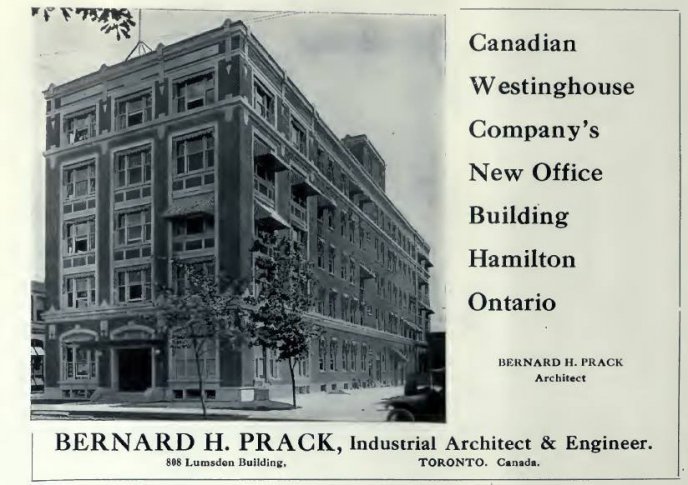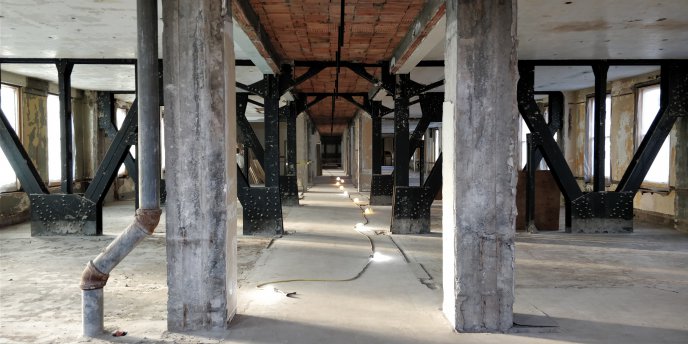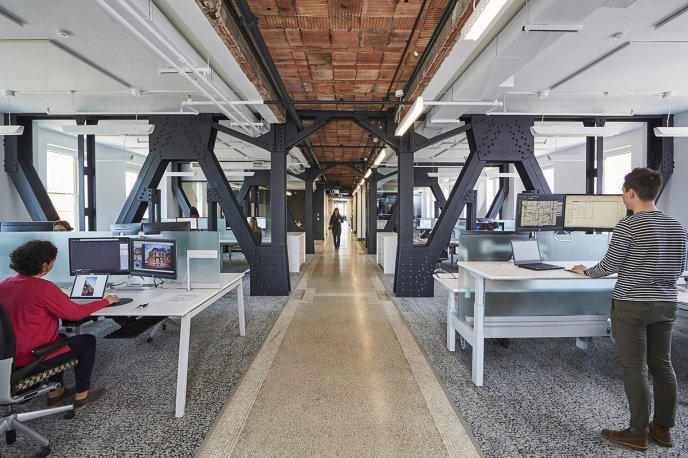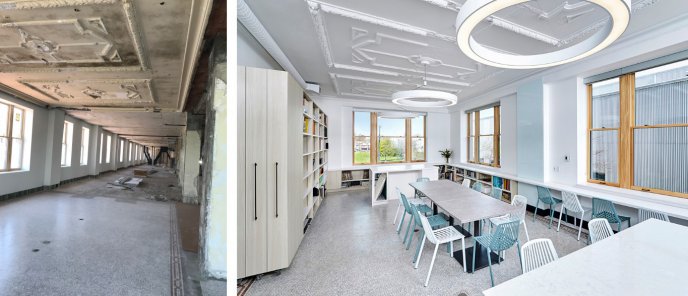Location: Hamilton
Date of Completion: 1917
Architect: Prack & Perrine
Date of Rehabilitation: 2019
Architect of Rehabilitation: McCallum Sather Architects Inc.
Nominated by: Andrea Horwath, MPP (Hamilton Centre)
“We consider ourselves as custodians of the building with a duty to preserve not only its architecture, but its history and its significance to the community.”
Meir Dick, founder of Electric City Developments
Having sat empty and neglected since the mid-1980s, this historic Hamilton landmark is getting a new lease on life, reinventing itself as a hub for commercial and cultural activities meant to catalyze revitalization far beyond its walls.

Image Credit:
Hamilton Construction Journal, 1916
Rise, Downfall and Revival
Dating back to 1917, the seven-storey Westinghouse Office Building was once the Canadian headquarters for Westinghouse Company—an electrical manufacturer that played a major role in Hamilton’s industrial growth, employing in its heyday 11,000 in the city alone and manufacturing varied items like transformers, hydro-electric generators, radios, stoves and refrigerators. The building was erected directly south of the company’s main plant in the city.
Designed by local architects Prack & Perrine (the predecessor firm of Prack & Prack, which would be behind other Hamilton landmarks like the Pigott Building), the original five-storey brick and stone clad building was an instant local landmark. It is representative of the industrial office buildings of the early 20th century in the region: an attractive yet functional building housing executives and administrative staff while projecting a successful corporate image. A two-storey addition in 1928 would further cement its position in the neighbourhood, dominating the surrounding low-rise buildings.
Unfortunately, like many other buildings in Hamilton, the Westinghouse Office Building emptied out in the 1980s, a victim of the economic woes ravishing the city. It was designated a heritage structure in 1988.
It would take over 30 years for the building to come back to life with an ambitious project that is converting this former headquarters into Westinghouse HQ: 80,000 square feet of class-A commercial space—the highest-quality office space possible—including a ground-floor event space and auditorium.

Image Credit: McCallum Sather Architects Inc.

Image Credit: McCallum Sather Architects Inc.
A 21st Century Office Building in a 20th Century Landmark
Part of the building’s revitalization has involved the careful preservation of much of the building’s exterior, and the re-discovery and conservation of countless interior architectural features including marble flooring, intricate crown mouldings, mosaic tiles and gigantic steel trusses.
However, this preservation has also been balanced with the integration of modern elements required in a 21st century office building, including new finishes and systems meant to enhance the sustainability of this heritage property.
When it comes to this merging of new meets old, the studio behind the building’s revitalization is walking the walk—McCallum Sather is not only the architect, heritage consultant and mechanical engineer behind the project, but it is also the first anchor tenant of the building. The firm’s space exemplifies its desire to balance 21st century office needs with preserving the period features that give the building its unique character.

Image Credit : McCallum Sather Architects Inc.
The McCallum Sather offices feature many original elements—including marble mosaic, terrazzo floors and exquisite plaster ceiling mouldings—while also integrating several sustainable technologies and innovative processes. This includes a central dedicated outdoor air system with on-demand control ventilation as well as daylight-sensor LED lights throughout the space to provide light only when needed, complementing the copious daylight provided by the numerous large windows. The building has also been retrofitted with energy-efficient operable windows to provide access to natural ventilation while still meeting heritage standards. Compared with a more traditional office environment, the design of the workspace has resulted in projected energy savings of more than 59 per cent and energy cost savings of 28 per cent.
This post forms part of our World Architecture Day Queen’s Park Picks 2019 series in which we asked Ontario’s Members of Provincial Parliament to nominate a prominent building, past or present, in their riding for a chance to learn more about it. Check out the rest of the series to learn more about great buildings across the province!